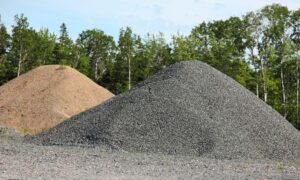
Handling sand and gravel is tough work. The constant abrasion and heavy loads demand equipment that can withstand serious wear and tear. Your industrial hose is a crucial link in these operations, as choosing the wrong hose can lead to costly downtime and even safety risks. Selecting the right hose for your specific needs means a longer lifespan for your equipment—saving you time and money.
At J.W. Roberts, we are your trusted source for all your industrial hose requirements. Our team can help you find the perfect solution for your material handling applications. Contact us today to learn more.
The Challenges of Working with Sand and Gravel
Sand and gravel are seemingly simple materials, but they are composed of hard, irregular particles that relentlessly grind against any surface they contact. This constant friction can impact equipment, especially industrial hoses used to transfer them at a rapid rate. Whether it’s conveying dry sand to a concrete mixer or pumping a slurry of gravel and water, the internal wear on hoses can be severe.
Beyond abrasion, the sheer volume and weight of the materials being moved create additional strain. Hoses must be both robust enough to handle high flow rates without collapsing and strong enough to withstand the pressure exerted by the heavy loads. Given the solid nature of the material, there is also a potential for blockages, which can cause pressure surges inside the hose.
Environmental factors add another layer of complexity. Extreme temperatures, UV exposure, and moisture can degrade the hose material over time, making it more brittle and susceptible to damage from the gravel and sand.
What to Look for in Your Industrial Hose
Consider these factors when selecting your industrial hose for sand and gravel handling.
Abrasion Resistance: Given the abrasive nature of the materials, the hose’s inner lining must be highly resistant to wear. Look for specialized rubber compounds like natural rubber or SBR with high abrasion resistance.
Pressure Rating: The hose’s pressure rating should always match or exceed the system’s operating pressure. Using an under-rated hose can lead to catastrophic failure.
Hose Construction: The reinforcement layer, such as textile braid or a wire helix, determines the hose’s strength and flexibility. Consider the application’s demands; some require high flexibility, while others need maximum strength.
Inner Diameter: The hose’s inner diameter (ID) affects the material flow rate. A larger ID allows for higher volumes but can also impact velocity and material settling.
Temperature Range: Operating temperatures and the temperature of the materials being conveyed must be within the hose’s specified temperature range.
We Can Help You Find the Right Industrial Hose
With extensive industry experience and a wide selection of high-quality hoses, we can source and ship all your essential industrial hose and accessories for your operation. Trust our team at J.W. Roberts for reliable solutions and unparalleled support.
